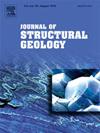Structural architecture and micromechanics of the carbonate-hosted low-angle normal fault, Agri Valley, southern Apennines, Italy
IF 2.6
2区 地球科学
Q2 GEOSCIENCES, MULTIDISCIPLINARY
引用次数: 0
Abstract
Slip along low-angle normal faults (LANFs) is theoretically inhibited by standard rock mechanics; however, they are well-documented in several orogenic belts. Frequently, LANFs originate along the brittle-ductile transition, where mylonitic textures form and promote strain localization during fault exhumation. Conversely, understanding how LANFs nucleate and grow in the purely brittle regime remains a crucial topic. To investigate this process, we study a carbonate-hosted LANF exhumed from shallow depths, and currently exposed in the Agri valley of southern Italy. The Marsicovetere-LANF (MLANF) is documented through field observations and microscale analysis. The fault exhibits a complex architecture, characterized by a thick fault zone including a low-angle principal slip surface (PSS), multiple sub-parallel slip surfaces (sss's) and R-shear structures. Field data suggest that low-angle slip surfaces result from the partially shear activation of bedding interfaces, while steeper R-shear structures, progressively growing adjacent to low-angle slip surfaces, facilitate stress concentration along well-oriented surfaces. The resulting fault architecture, defined by a ramp-flat-ramp geometry, arises from the interaction between steeper R-shear structures and gently dipping flat segments. At the microscale, fluidized ultracataclatic layers are frequently observed. We propose that rupture propagation, likely nucleating along steeper R-shear structures, occurs due to fluidization processes activated along low-angle surfaces. This model provides a potential explanation for the nucleation and growth of LANFs in a purely brittle regime.
意大利亚平宁半岛南部阿格里山谷碳酸盐岩基低角度正断层的结构构造和微观力学
从理论上讲,低角度正断层(LANFs)的滑动是受到标准岩石力学抑制的;然而,在几个造山带中,LANFs 的滑动却得到了充分的证实。低角度正断层通常起源于脆性-韧性过渡带,这里形成了熔岩质地,并在断层剥离过程中促进了应变局部化。相反,了解 LANF 如何在纯脆性机制中成核和生长仍然是一个至关重要的课题。为了研究这一过程,我们研究了一个从浅层掘出的碳酸盐岩承载的 LANF,它目前暴露在意大利南部的 Agri 谷地。我们通过实地观察和微观分析记录了 Marsicovetere LANF(MLANF)。该断层呈现出复杂的结构,其特点是断层带较厚,包括一个低角度主滑动面(PSS)、多个次平行滑动面(sss)和 R 型剪切结构。实地数据表明,低角度滑动面是由部分剪切激活的基底界面造成的,而较陡的 R 型剪切结构则是在低角度滑动面附近逐渐形成的,有利于应力沿走向良好的表面集中。陡峭的 R 型剪切结构与平缓倾斜的平面区段相互作用,形成了斜坡-平面-斜坡几何形状的断层结构。在微观尺度上,经常可以观察到流体化的超骤变层。我们认为,断裂扩展可能是沿着较陡的 R 形剪切结构成核的,是由于沿着低角度表面激活的流化过程而发生的。该模型为 LANFs 在纯脆体系中的成核和生长提供了潜在的解释。
本文章由计算机程序翻译,如有差异,请以英文原文为准。
求助全文
约1分钟内获得全文
求助全文
来源期刊

Journal of Structural Geology
地学-地球科学综合
CiteScore
6.00
自引率
19.40%
发文量
192
审稿时长
15.7 weeks
期刊介绍:
The Journal of Structural Geology publishes process-oriented investigations about structural geology using appropriate combinations of analog and digital field data, seismic reflection data, satellite-derived data, geometric analysis, kinematic analysis, laboratory experiments, computer visualizations, and analogue or numerical modelling on all scales. Contributions are encouraged to draw perspectives from rheology, rock mechanics, geophysics,metamorphism, sedimentology, petroleum geology, economic geology, geodynamics, planetary geology, tectonics and neotectonics to provide a more powerful understanding of deformation processes and systems. Given the visual nature of the discipline, supplementary materials that portray the data and analysis in 3-D or quasi 3-D manners, including the use of videos, and/or graphical abstracts can significantly strengthen the impact of contributions.
 求助内容:
求助内容: 应助结果提醒方式:
应助结果提醒方式:


